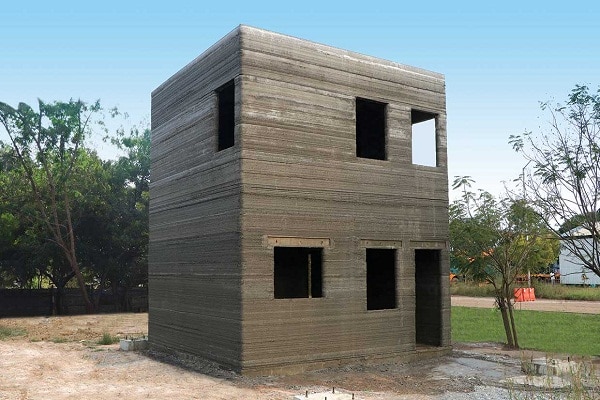Just along concrete’s gray surface, a chemical reaction is occurring. Known as carbonation, this reaction forms calcium carbonate, a benign chalk-like material, but it can also affect climate change.
That’s because calcium carbonate forms when CO2 from the air reacts with water in concrete pores, and then with calcium compounds in concrete — meaning that concrete is a potential carbon sink. Estimating the extent of its carbon uptake at scale, however, has proven difficult.
In a new paper, MIT researchers investigate the carbon uptake of all pavements in the United States. The study finds that the carbonation process could offset 5 percent of the CO2 emissions generated from cement used in U.S. pavements. Much of those offsets, the researchers find, could occur years after pavements have been demolished, especially in states that use composite pavement designs.
Postdoc Hessam AzariJafari, working within the MIT Concrete Sustainability Hub (CSHub), is first author of the new paper, which was published online in Resources, Conservation and Recycling on Jan. 11. Co-authors on the work include civil and environmental engineering graduate student Fengdi Guo and CSHub Director Jeremy Gregory as well as Randolph Kirchain of the MIT Materials Research Laboratory.
Weighing uptake
Though all concrete experiences carbonation to some degree, the magnitude depends on how large the concrete surface is that’s exposed to air. That can make estimating carbon uptake challenging. While many buildings use concrete, the exposure of that concrete varies widely by design. In pavements, it’s a different story.
“There’s a big opportunity for [carbon uptake] in concrete pavements,” says AzariJafari, “because usually the surface-to-volume ratio of concrete pavements is 10 times bigger than the surface-to-volume ratio of concrete elements in a building.”
But just because it’s easier for that uptake to occur doesn’t mean it’s easy to estimate. Numerous factors like pavement geometry and maintenance, climate, and ingredients all determine a pavement’s carbon uptake. What’s more, carbon uptake will continue even after that pavement’s demolition, depending on how its concrete waste is stored.
Past research on carbonation has struggled to manage these uncertain variables. To simplify calculations, most approaches tend to infer pavement properties and not incorporate challenging but important parameters, such as maintenance actions, which can “reset” the carbonation process.
In his work, AzariJafari and colleagues expand the scope of pavement carbonation research by developing an extensive pavement management model that can estimate carbon uptake in high resolution.
“Pavement management models are a type of tool that transportation agencies can use to predict and decide where and when to implement certain treatment actions based on an available budget,” explains AzariJafari. “We developed this kind of pavement management system model for the whole U.S. network.”
Before he could run the model, he quantified several uncertainties that could lead to variations in carbon uptake.
The greatest uncertainty in his model was climate. A number of differing climate zones exist across the United States, and each zone will affect carbonation differently. In areas with more precipitation, carbonation can occur at a greater depth in the concrete, but will also occur at a lesser magnitude than in drier areas.
Material variation also introduces uncertainty. Certain binders in concrete may possess different concentrations of calcium oxide, the ingredient that reacts with CO2, and the availability and use of those binders varies widely across the United States. Additionally, each time a pavement receives a treatment the new concrete surface will undergo more intense carbonation, further complicating uptake estimations.
Perhaps the most uncertain factor is concrete rubble sizes after demolition. Once a pavement has received a maintenance action, the concrete waste from those actions will sit in landfills, where the carbonation process continues. Depending on how that waste is arranged — the more spread out, the better — it can have a greater uptake.
Carbon captured
By running thousands of simulations, AzariJafari could predict how uncertainties would likely play out over his study’s 30-year analysis period. He then used these predictions to calculate the potential carbon uptake in each state based on the road conditions, maintenance actions, budgets, and road lengths from his model.
“We found that after this 30-year analysis period, we expect to have similar uptake from the use and end-of-life phases,” says AzariJafari. “In total, we found that 5.8 MT [million tons] CO2 could be sequestered, with 2.8 MT CO2 coming from the use phase and 3 MT CO2 coming from end-of-life.”
He found that states with large networks with many concrete pavements, such as Texas and California, saw a greater uptake during the use phase, while states that paved with composite designs (an asphalt overlay over a concrete layer) saw greater carbon uptake during end-of-life.
Since these composite designs require more maintenance actions, they could generate more concrete waste which, in turn, led to significant end-of-life carbon uptake. In fact, Massachusetts, which relies heavily on composite designs, could see more end-of-life uptake than California.
It’s important to note that end-of-life uptake also saw greater variation due to uncertainty in landfill practices, such as the geometry of the waste piles.
“It should also be considered that some countries, like the Netherlands or Singapore, may not have enough space to spread out all these demolished materials at all,” notes AzariJafari. These countries could, however, recycle that waste for use in future concrete production, even if that precludes the potential for carbon uptake.
Though uncertainties inherent to end-of-life landfilling remain, AzariJafari has found that landfilling is a more cost-effective form of carbon uptake than artificial carbon capture and sequestration — at least until carbon-capture technologies become more robust.
Source: MIT










